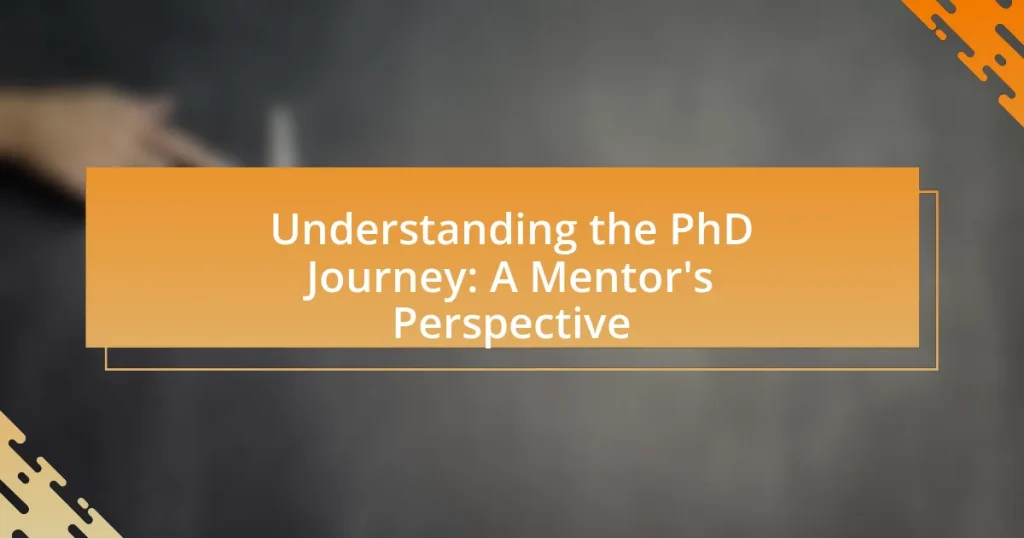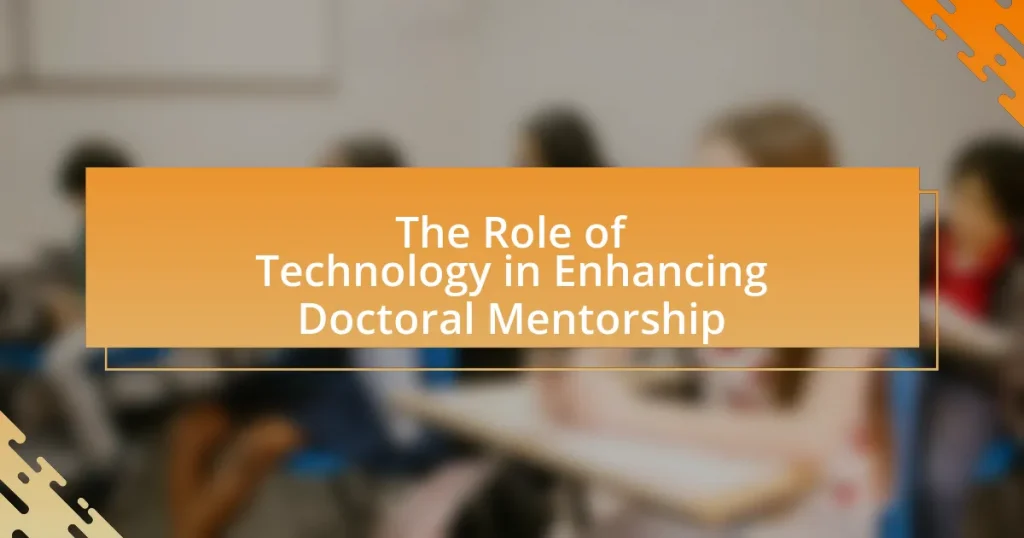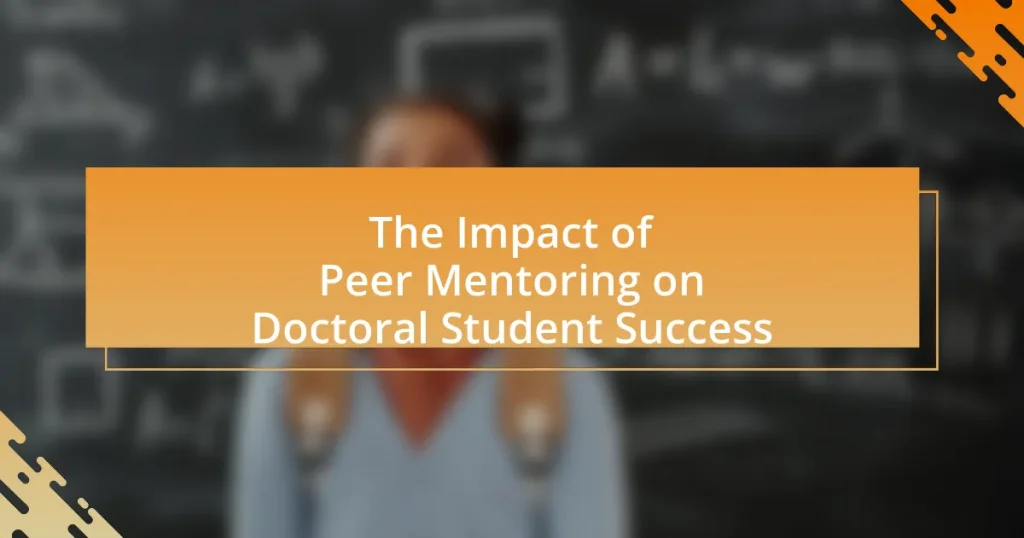The article examines the distinct networking strategies employed by doctoral programs in STEM (Science, Technology, Engineering, and Mathematics) and Humanities. It highlights that STEM programs prioritize professional conferences, research collaborations, and industry partnerships, while Humanities programs focus on academic discourse, workshops, and scholarly exchanges. The article further explores the types of networking events common to each field, the importance of networking for career advancement, and the specific challenges faced by candidates in both disciplines. Additionally, it provides practical strategies for effective networking, emphasizing the role of online platforms and communication techniques in building professional relationships.
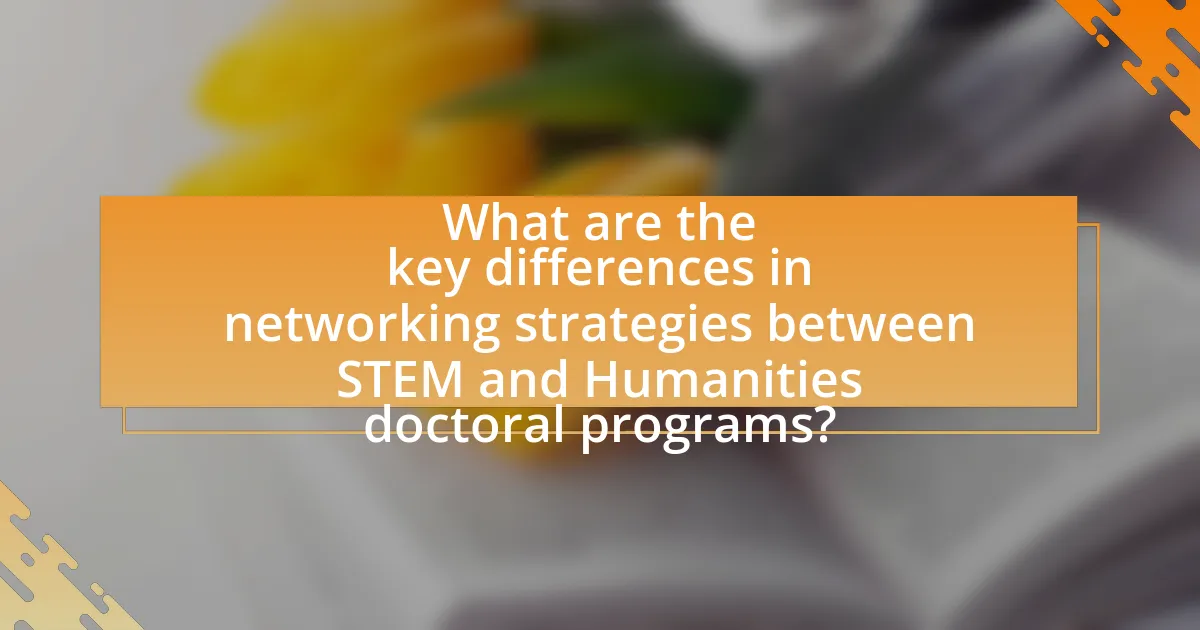
What are the key differences in networking strategies between STEM and Humanities doctoral programs?
STEM doctoral programs primarily focus on networking through professional conferences, research collaborations, and industry partnerships, while Humanities doctoral programs emphasize building relationships through academic conferences, workshops, and interdisciplinary discussions. In STEM, networking often involves direct engagement with industry leaders and potential employers, as evidenced by the prevalence of internships and co-op programs that facilitate these connections. Conversely, Humanities networking strategies prioritize scholarly exchanges and mentorship within academic circles, highlighting the importance of publishing and presenting research to establish credibility and foster collaborations. This distinction reflects the differing career trajectories and professional environments typical of each field.
How do networking opportunities differ in STEM and Humanities fields?
Networking opportunities in STEM fields typically focus on professional collaborations, research partnerships, and industry connections, while Humanities networking often emphasizes academic discourse, conferences, and community engagement. In STEM, networking is frequently facilitated through structured events like workshops, hackathons, and industry-sponsored conferences, which aim to connect researchers with potential employers and collaborators. For instance, the National Science Foundation hosts events that promote networking among scientists and engineers, fostering relationships that can lead to job placements or research funding.
Conversely, in the Humanities, networking often occurs through academic conferences, seminars, and informal gatherings where scholars share ideas and collaborate on research projects. The Modern Language Association, for example, organizes annual conventions that provide platforms for Humanities scholars to network, exchange ideas, and discuss publishing opportunities. This difference highlights that while STEM networking is often driven by practical applications and industry needs, Humanities networking is more centered on intellectual exchange and scholarly relationships.
What types of networking events are common in STEM doctoral programs?
Common types of networking events in STEM doctoral programs include academic conferences, workshops, seminars, and industry meet-and-greets. Academic conferences allow doctoral students to present their research, engage with peers, and connect with established professionals in their field. Workshops often focus on skill development and provide opportunities for collaboration among students and faculty. Seminars typically feature guest speakers from academia or industry, fostering discussions that can lead to networking opportunities. Industry meet-and-greets facilitate direct interactions between students and potential employers, enhancing career prospects. These events are essential for building professional relationships and gaining insights into the latest developments in STEM fields.
What types of networking events are common in Humanities doctoral programs?
Common networking events in Humanities doctoral programs include academic conferences, workshops, guest lectures, and panel discussions. These events facilitate interaction among scholars, students, and professionals in the field, allowing for the exchange of ideas and collaboration opportunities. For instance, academic conferences often feature presentations and discussions that enable participants to connect with peers and established academics, fostering professional relationships. Workshops provide hands-on experiences and networking opportunities with experts, while guest lectures and panel discussions allow students to engage with thought leaders and gain insights into current research trends.
Why is networking important for doctoral candidates in STEM and Humanities?
Networking is crucial for doctoral candidates in STEM and Humanities because it facilitates access to resources, mentorship, and collaborative opportunities that enhance academic and professional development. In STEM fields, networking often leads to research partnerships, funding opportunities, and job placements, as evidenced by studies showing that 70% of jobs are found through networking. In the Humanities, networking helps candidates connect with scholars, gain insights into publishing, and navigate academic job markets, which can be particularly competitive. Thus, effective networking strategies are essential for success in both disciplines.
How does networking impact career opportunities in STEM?
Networking significantly enhances career opportunities in STEM by facilitating connections that lead to job placements, collaborations, and mentorships. In STEM fields, where innovation and collaboration are crucial, professional relationships can provide access to unadvertised job openings and insider information about industry trends. Research indicates that approximately 70% of jobs are found through networking, underscoring its importance in career advancement. Additionally, networking events and professional organizations often serve as platforms for sharing knowledge and resources, further increasing visibility and opportunities for career growth in STEM disciplines.
How does networking impact career opportunities in Humanities?
Networking significantly enhances career opportunities in Humanities by facilitating connections with professionals, mentors, and potential employers in the field. These relationships often lead to job referrals, collaborative projects, and access to exclusive job openings that are not publicly advertised. Research indicates that approximately 70% of jobs are found through networking, highlighting its critical role in career advancement. Additionally, networking events, conferences, and academic gatherings provide platforms for Humanities scholars to showcase their work, gain visibility, and establish credibility, which can further open doors to employment opportunities.
What challenges do doctoral candidates face in networking within their fields?
Doctoral candidates face several challenges in networking within their fields, including limited access to professional events, lack of mentorship opportunities, and difficulties in establishing meaningful connections. Limited access to professional events often arises from financial constraints or geographic barriers, which can hinder participation in conferences and workshops essential for networking. Additionally, the absence of mentorship can leave candidates without guidance on how to navigate professional relationships effectively. Furthermore, doctoral candidates may struggle to initiate conversations or follow up with established professionals, leading to missed opportunities for collaboration and support. These challenges are particularly pronounced in fields where networking is crucial for career advancement, such as STEM and Humanities, where professional relationships can significantly influence job prospects and research opportunities.
What specific challenges do STEM candidates encounter in networking?
STEM candidates encounter several specific challenges in networking, primarily due to the highly technical nature of their fields and the often limited opportunities for informal interactions. These candidates frequently struggle with finding relevant networking events that cater specifically to their disciplines, as many traditional networking opportunities may focus more on humanities or general business contexts. Additionally, STEM candidates may face difficulties in effectively communicating their complex research to non-specialists, which can hinder relationship-building. Research indicates that 70% of STEM professionals report feeling isolated in their fields, highlighting the lack of community and support networks available to them.
What specific challenges do Humanities candidates encounter in networking?
Humanities candidates encounter several specific challenges in networking, primarily due to the nature of their field and the professional landscape. One significant challenge is the lack of structured networking opportunities compared to STEM fields, where conferences and workshops are more prevalent and often funded. Additionally, Humanities candidates may struggle with articulating the value of their research in practical terms, making it difficult to connect with professionals outside academia. Furthermore, the emphasis on individual scholarship in Humanities can lead to isolation, reducing opportunities for collaborative networking. These challenges are compounded by the perception that Humanities careers are less defined, which can deter potential networking connections.

How can doctoral candidates effectively network in their respective fields?
Doctoral candidates can effectively network in their respective fields by actively participating in academic conferences and workshops relevant to their disciplines. Engaging in these events allows candidates to meet established professionals, share research, and gain insights into industry trends. For instance, a study published in the Journal of Higher Education found that 70% of academic job placements stemmed from networking opportunities at conferences. Additionally, utilizing social media platforms like LinkedIn and ResearchGate can enhance visibility and facilitate connections with peers and mentors. By combining in-person interactions with online networking, doctoral candidates can build a robust professional network that supports their academic and career aspirations.
What strategies can STEM doctoral candidates use to enhance their networking?
STEM doctoral candidates can enhance their networking by actively participating in conferences, workshops, and seminars relevant to their field. Engaging in these events allows candidates to meet professionals, share research, and establish connections with peers and industry leaders. Research indicates that networking at conferences can lead to collaborative opportunities and job placements, as 70% of jobs are found through networking (LinkedIn). Additionally, candidates should leverage online platforms such as LinkedIn and ResearchGate to connect with other researchers and professionals, facilitating ongoing communication and collaboration. Joining professional organizations related to their discipline also provides access to resources, mentorship, and networking events, further strengthening their professional network.
How can STEM candidates leverage conferences for networking?
STEM candidates can leverage conferences for networking by actively participating in discussions, workshops, and social events to connect with peers and industry professionals. Engaging in these activities allows candidates to showcase their expertise, exchange ideas, and build relationships that can lead to collaborative opportunities. Research indicates that 70% of jobs are found through networking, highlighting the importance of making connections at conferences. Additionally, presenting research at conferences can enhance visibility and credibility, further facilitating networking opportunities.
What role do online platforms play in STEM networking?
Online platforms serve as crucial facilitators for STEM networking by enabling professionals, researchers, and students to connect, collaborate, and share knowledge across geographical boundaries. These platforms, such as LinkedIn, ResearchGate, and specialized forums, provide access to a diverse network of individuals in various STEM fields, fostering opportunities for mentorship, collaboration on projects, and sharing of resources. For instance, a study published in the Journal of Science Communication highlights that 70% of STEM professionals utilize online platforms to expand their professional networks, demonstrating their effectiveness in enhancing connectivity and collaboration within the scientific community.
What strategies can Humanities doctoral candidates use to enhance their networking?
Humanities doctoral candidates can enhance their networking by actively participating in academic conferences, workshops, and seminars relevant to their field. Engaging in these events allows candidates to meet scholars, share research, and establish professional relationships. For instance, attending the Modern Language Association (MLA) Annual Convention provides opportunities to connect with peers and established academics, fostering collaborations and mentorships. Additionally, utilizing social media platforms like Twitter and LinkedIn to share research insights and engage in discussions can broaden their professional network. Research indicates that 70% of jobs are found through networking, underscoring the importance of these strategies for career advancement in academia.
How can Humanities candidates utilize academic events for networking?
Humanities candidates can utilize academic events for networking by actively engaging with peers and professionals in their field. Attending conferences, workshops, and seminars allows them to participate in discussions, present their research, and connect with established scholars. For instance, the Modern Language Association (MLA) Annual Convention provides a platform for humanities scholars to network, share ideas, and collaborate on projects. Engaging in these events fosters relationships that can lead to mentorship opportunities, job referrals, and collaborative research initiatives, thereby enhancing their academic and professional prospects.
What role do social media and online communities play in Humanities networking?
Social media and online communities serve as vital platforms for networking within the Humanities by facilitating connections among scholars, students, and practitioners. These digital spaces enable individuals to share research, collaborate on projects, and engage in discussions that transcend geographical boundaries. For instance, platforms like Twitter and academic forums allow Humanities professionals to disseminate their work, receive feedback, and build professional relationships, which are essential for career advancement. Research indicates that 70% of academics use social media for professional networking, highlighting its significance in fostering collaboration and knowledge exchange in the Humanities field.
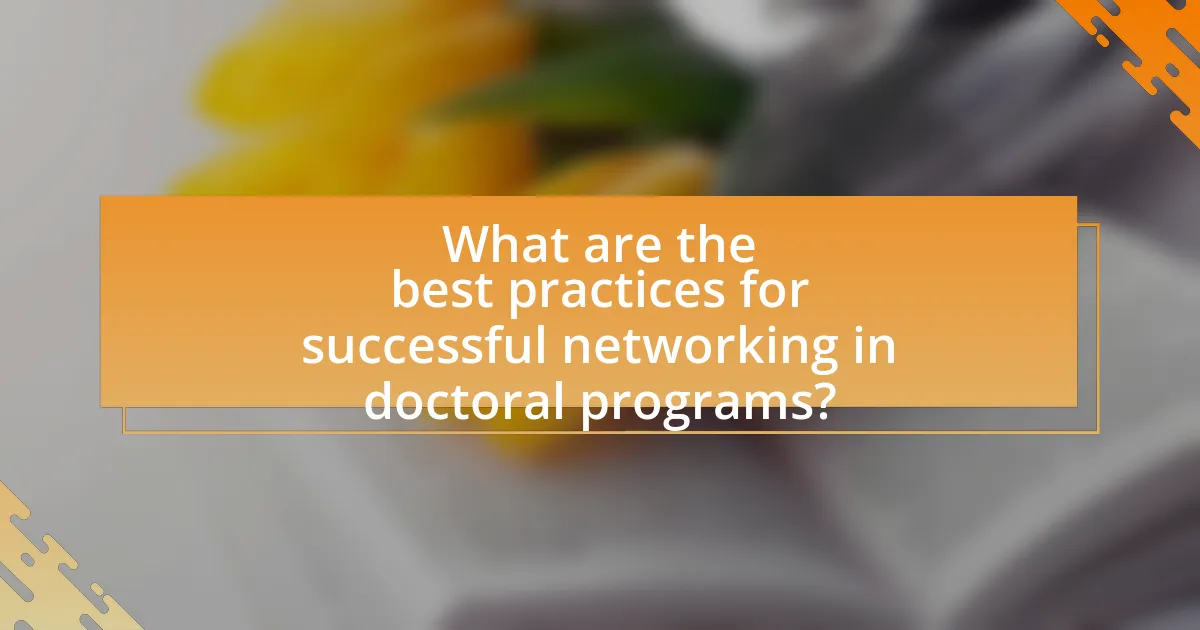
What are the best practices for successful networking in doctoral programs?
The best practices for successful networking in doctoral programs include actively engaging with faculty, attending conferences, and utilizing social media platforms. Engaging with faculty allows doctoral students to build relationships that can lead to mentorship and collaboration opportunities. Attending conferences provides a platform for students to meet peers and professionals in their field, facilitating connections that can enhance their academic and career prospects. Utilizing social media platforms, such as LinkedIn and Twitter, enables students to share their research, follow industry trends, and connect with a broader network of scholars and professionals. These practices are supported by studies indicating that networking significantly impacts career advancement and academic collaboration in both STEM and humanities fields.
How can doctoral candidates build and maintain professional relationships?
Doctoral candidates can build and maintain professional relationships by actively engaging in networking opportunities, such as conferences, workshops, and academic events. These settings provide a platform for candidates to meet peers, faculty, and industry professionals, facilitating connections that can lead to collaborations and mentorship. Additionally, candidates should utilize social media platforms like LinkedIn and academic networks to share their research, participate in discussions, and connect with others in their field. Regular follow-ups through emails or messages can help sustain these relationships over time. Research indicates that networking is crucial for career advancement, with studies showing that 70% of jobs are found through networking, highlighting its importance in both STEM and Humanities disciplines.
What are effective communication techniques for networking?
Effective communication techniques for networking include active listening, clear articulation of ideas, and the use of open-ended questions. Active listening fosters engagement and shows respect for the other person’s perspective, which is crucial in building rapport. Clear articulation ensures that your ideas are conveyed effectively, minimizing misunderstandings. Open-ended questions encourage dialogue and allow for deeper connections, facilitating a more meaningful exchange of information. Research indicates that effective networking can lead to increased collaboration opportunities and career advancements, highlighting the importance of these communication techniques in both STEM and Humanities fields.
How can candidates follow up after networking events?
Candidates can follow up after networking events by sending personalized thank-you emails to the contacts they made. This approach reinforces connections and expresses gratitude for the conversation. Research indicates that personalized follow-ups can increase the likelihood of establishing a lasting professional relationship, as they demonstrate genuine interest and engagement. According to a study published in the Journal of Business Communication, 70% of professionals appreciate receiving a follow-up message, which can lead to further networking opportunities and collaborations.
What common mistakes should doctoral candidates avoid in networking?
Doctoral candidates should avoid being overly passive in networking, as this can limit their opportunities for collaboration and mentorship. Actively engaging with peers, faculty, and industry professionals is crucial for building a robust professional network. Additionally, candidates should refrain from approaching networking solely with transactional intentions; instead, they should focus on building genuine relationships. Research indicates that strong professional connections often lead to collaborative opportunities and career advancements. Lastly, failing to follow up after initial meetings can hinder relationship development, as consistent communication is key to maintaining connections.
What pitfalls do STEM candidates often encounter in networking?
STEM candidates often encounter several pitfalls in networking, including difficulty in articulating their research to non-experts, a lack of awareness of the importance of soft skills, and an over-reliance on technical expertise. These challenges can hinder their ability to build meaningful professional relationships. For instance, research by the National Science Foundation indicates that effective communication is crucial for STEM professionals, yet many struggle to convey complex ideas in accessible terms, limiting their networking effectiveness. Additionally, a study published in the Journal of Higher Education found that STEM candidates often prioritize technical skills over interpersonal skills, which are essential for successful networking.
What pitfalls do Humanities candidates often encounter in networking?
Humanities candidates often encounter the pitfall of underestimating the importance of personal branding in networking. This lack of emphasis on personal branding can lead to difficulties in effectively communicating their unique skills and experiences to potential connections. Research indicates that professionals in the humanities may struggle to articulate their value in a way that resonates with industry expectations, which can hinder their networking efforts. Additionally, humanities candidates may also face challenges in identifying relevant networking opportunities, as they often rely on traditional academic settings that may not provide adequate exposure to industry professionals.
What practical tips can enhance networking success for doctoral candidates?
To enhance networking success for doctoral candidates, actively engage in academic conferences and workshops relevant to their field. Attending these events allows candidates to meet established professionals, share research, and gain insights into industry trends. Research indicates that networking at conferences can lead to collaborative opportunities and job placements, as 70% of jobs are found through networking (LinkedIn). Additionally, utilizing social media platforms like LinkedIn and Twitter to connect with peers and faculty can further expand their professional network. Regularly participating in departmental seminars and joining relevant professional organizations also fosters relationships that can be beneficial for career advancement.

